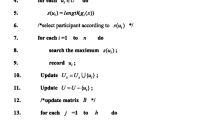Abstract
Participant selection is a fundamental challenge to perform sensing tasks with adequate data quality in various mobile crowdsensing (MCS) applications. In this paper, we explore participant selection mechanisms with sensing-gain constraints in MCS. First, we propose a novel quality-aware participant reputation model with active factors. Second, since user density differs in various applications, we propose two kinds of sensing-gain constrained participant selection mechanisms with both sufficient and insufficient user resources. Particularly, in the case of sufficient user resources, we formulate the sensing-gain objective on recruit cost and participant scale under constraints on data quality and task coverage, and propose a M ulti-S tage D ecision mechanism via G reedy strategy (MSD-G); in the case of insufficient user resources, we formulate the sensing-gain objective on data quality, abstract it as a 0-1 knapsack problem, and devise a S ensing-G ain C onstrained D ynamic P rogramming (SGC-DP) mechanism. Extensive simulations over a real-world dataset have verified that our participant reputation model with active factors can distinguish high-quality participants with different active levels, and our MSD-G and SGC-DP algorithms can effectively select suitable participants with ideal recruit budget and guaranteed data quality.













Similar content being viewed by others
References
Guo B, Zhai S, Yu Z et al (2017) Crowdsensing big data: sensing data selection, and understanding. Big Data Res 3(5):57–69
Hu J, Tao D (2019) Theories and methods of quality measure and assurance for mobile crowd sensing. J Chin Comput Syst 40(5):918–923
Yu Z, Zhang D, Yu Z et al (2015) Participant selection for offline event marketing leveraging Location-Based social networks. IEEE Trans Syst Man Cybern Syst 45(6):853–864
Zhang X, Sun W, **ng K (2016) Incentives for mobile crowd sensing: a survey. IEEE Commun Surv Tutor 18(1):54–67
Jurca R (2002) Towards incentive-compatible reputation management. In: International Conference on Trust Springer-Verlag
Yan J, Ku S, Yu C (2017) Reputation model of crowdsourcing workers based on active degree. J Comput Appl 37(7):2039–2043
Pournajaf L, **ong L, Sunderam V, Goryczka S (2014) Spatial task assignment for crowd sensing with cloaked locations. In: IEEE 15th International Conference on Mobile Data Management, Brisbane, QLD, pp 73–82
Liu C, Zhang B, Su X et al (2017) Energy-aware participant selection for smartphone-enabled mobile crowd sensing. IEEE Syst J 11(3):1435–1446
Zhang D, **ong H, Wang L (2014) Crowdrecruiter: selecting participants for piggyback crowdsensing under probabilistic coverage constraint. In: ACM International Joint Conference on Pervasive & Ubiquitous Computing
Guo W, Zhu W, Yu Z, Wang J, Guo B (2019) A survey of task allocation: contrastive perspectives from wireless sensor networks and mobile crowdsensing. IEEE Access 7:78406–78420
Wang J, Wang Y, Zhang D et al (2018) Multi-task allocation in mobile crowd sensing with individual task quality assurance. IEEE Trans Mobil Comput 17(9):2101–2113
Liu L, Song Y, Zhang H, Ma H et al (2015) Physarum optimization: a biology-inspired algorithm for the Steiner tree problem in networks. IEEE Trans Comput 64(3):819–832
Yang J, Li P, Wang H (2017) Participant reputation aware data collecting mechanism for mobile crowd sensing. In: 2017 IEEE/CIC International Conference on Communications in China (ICCC), pp 1–6
Yu Z, Zheng X, Huang F et al (2019) A framework based on sparse representation model for time series prediction in Smart City. Front Comput Sci
Wang J, Wang F, Wang Y (2020) Hytasker: hybrid task allocation in mobile crowd sensing. IEEE Trans Mobil Comput 19(3):598–611
Yu Z, Guo W, Zhang D, Wang L, Guo B (2020) Cyber-physical-social-mediated communication. IT Prof 22(2):60–66
Chen X, Xu J, Wu M, Dai H (2015) Research of data collection technology in crowd sensing based on social behavior analysis. Appl Res Comput 32(12):3534–3541
Yu Z, Zhang D, Yu Z, Yang D (2015) Participant selection for offline event marketing leveraging location-based social networks. IEEE Trans Syst Man Cybern Syst (TSMC-S) 45(6):853– 864
Liu C, Zhang B, Su X et al (2015) Energy-Aware Participant selection for smartphone-enabled mobile crowd Sensing[J]. IEEE Syst J 1–12
Zhao D, Li X, Ma H (2016) Budget-feasible online incentive mechanisms for crowdsourcing tasks truthfully. ACM/IEEE Trans Netw 24(2):647–661
**ao M, Wu J, Huang L et al (2015) Multi-task assignment for crowdsensing in mobile social networks. In: Computer Communications IEEE
Karaliopoulos M, Telelis O, Koutsopoulos I (2015) User recruitment for mobile crowdsensing over opportunistic networks. In: IEEE Computer Communications
**ao M, Huang L et al (2017) Online task assignment for crowdsensing in predictable mobile social networks. IEEE Trans Mobil Comput 16(8):2306–2320
Nan WQ (2016) Quality-enhanced incentive mechanism based on mobile crowd sensing. Northwestern Polytechnical University
Liu L, Liu W, Zheng Y, Ma H D (2018) Third-Eye: a mobilephone-enabled crowdsensing system for air quality monitoring. Proc ACM Interact Mob Wearable Ubiquitous Technol 26:1–20
Acknowledgments
Thanks Prof. Liang Liu in IoT technology laboratory of Bei**g University of Posts and Telecommunications for providing all the materials of “Third-Eye” project.
Funding
This work is supported in part by the National Natural Science Foundation of China under Grant No. 61872027 and No. 62072029, Open Research Fund of the State Key Laboratory of Integrated Services Networks under Grant No. ISN21-16, and Bei**g NSF No. L192004.
Author information
Authors and Affiliations
Corresponding author
Ethics declarations
The authors declare that there is no conflict of interest.
Additional information
Publisher’s note
Springer Nature remains neutral with regard to jurisdictional claims in published maps and institutional affiliations.
Rights and permissions
About this article
Cite this article
Tao, D., Gao, R. & Sun, H. Sensing-gain constrained participant selection mechanism for mobile crowdsensing. Pers Ubiquit Comput 27, 631–645 (2023). https://doi.org/10.1007/s00779-020-01470-8
Received:
Accepted:
Published:
Issue Date:
DOI: https://doi.org/10.1007/s00779-020-01470-8




